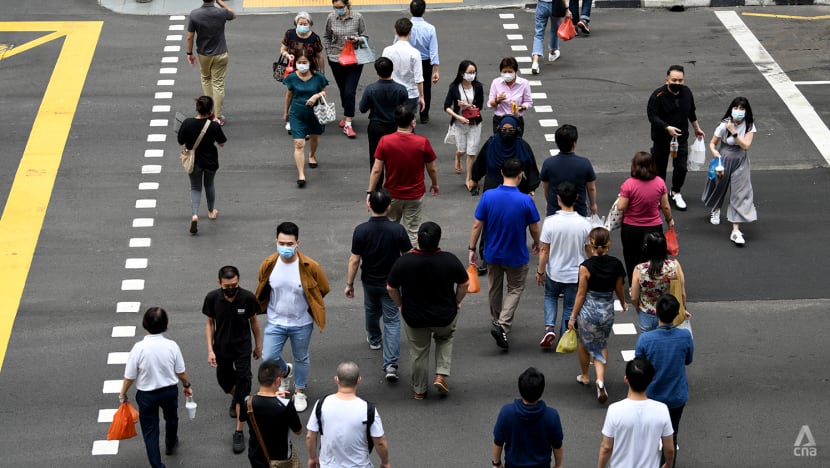Commentary: Too few in Singapore understand the impact of inflation on investments and savings
Inflation can erode purchasing power and gains in investing, yet few in Singapore actively look at how to rebalance their investment portfolios, says St James’s Place Wealth Management Asia CEO Gary Harvey.

A backdrop of Singapore's central business district. (Photo: AFP/Roslan Rahman)
SINGAPORE: From groceries to computers, cars and clothing, the world is already paying more for everyday expenses.
With vaccination efforts advanced in most developed economies in tandem with plans to move into an endemic phase of COVID-19, eyes have turned to the next stage of global economic recovery as lockdown measures are eased.
But while the gradual reopening of economies has helped some of the hardest hit sectors such as hospitality and retail to recover with the return of customers, the rising spectre of inflation is now rearing its head and threatening to undo all these efforts.
Mounting oil and gas prices and pandemic-related supply chain disruptions have also driven up freight rates, feeding into a steady climb in global commodity prices.
Singapore feels these effects keenly, having already recorded a rise in headline inflation to 4 per cent in December 2021 from 3.8 per cent in November, registering the highest inflation figures for almost a decade. The Monetary Authority of Singapore (MAS) further tightened monetary policy in late January in order to counter the creeping inflation and ensure price stability in the medium term.
Economists and policymakers have sounded the alarm over inflation as a key risk for economic recovery.
In the United States, the discourse has now shifted from the usual wolf cries over “transitory” inflation, towards the not-so-transitory reality of long-term inflationary pressures. The US Federal Reserve is now making clear its plans to pivot towards an even tighter monetary policy this coming year to control inflationary risks.
WHAT DOES THIS ALL MEAN FOR SINGAPOREANS?
The increased prices will lead to erosion in the value of an individual’s earnings and savings, and to deter excessive spending. In the longer-term, a high rate of inflation will dilute consumers’ purchasing power and erode corporate margins while accelerating instabilities in the economy.
Last year, Singapore was ranked the second most expensive city in the world, according to the 2021 Worldwide Cost of Living survey by the Economist Intelligence Unit (EIU).
Investors here too face the challenge of high living costs, with nearly half (47 per cent) saying that this is a factor preventing them from investing more into their savings and investments, based on a study by St James’s Place Wealth Management Asia (SJP Asia).

This is especially concerning with a potential GST hike on the cards, which can spell a perfect storm for economic slowdown and recession, and complicate investing to offset inflation. With many having inadequate savings already, higher inflation requires people’s money to work even harder for them.
Yet in Singapore, only half (52 per cent) of Singaporeans surveyed in 2021 consider inflation in their financial plans and its impact on their savings, according to a study by SJP Asia.
This is despite the fact that over two-thirds (69 per cent) are worried about Singapore’s high cost of living in the future, with almost half (47 per cent) saying they would invest more in equities – an asset class for which the annual returns usually outpaces and acts as an effective hedge against inflation.
While the logical solution points to the need for investments to cushion any inflationary blows, there are still high barriers stopping individuals from becoming investors and a big part stems from a gap in financial literacy.
The result is thinking that you do not have enough money to start investing and believing that it is just too difficult.
Even though Singaporeans are conscious of the impact of the city’s high living costs on their wallets, many lack the foresight to plan for the long term and have a false impression that it will be easier to save more when they are older and making more money.
What they do not realise is that, while this is partly true, the earlier one starts investing, the more time they will have to weather the ups and downs of the market, embed healthy financial habits, and generally take advantage of lower lifestyle costs – lifestyle spending naturally increases with earnings.
WORSE WHEN MANY DO NOT HAVE A FINANCIAL PLAN
The trouble is inflation creates a disincentive to save and invest. In ordinary times, getting a S$1,000 raise does not lead to people saving the full S$1,000, thanks to “lifestyle inflation” where people spend more as their individual income rises because they believe the additional goods and services they can now afford will make them happier.
This can make it difficult to get out of debt, save for retirement or meet other big-picture financial goals.
Even when more may be tempted to cut back on consumption as everyday expenses go up, individuals can get stuck in a cycle of living month-to-month on their salaries where they have just enough money to pay the bills every month and likely to find themselves short of money in old age.
Even for people who do not fit this mould, nearly a quarter of Singaporeans (24 per cent) expressed that it is the lack of a financial plan which is holding them back from committing more into their savings and investments.
In a time where stock markets are gyrating wildly in reaction to changing economic conditions and regulatory moves to cool the market while keeping the economy stewing, inexperienced or disengaged investors may pay a bigger price even when they do try to plan for their futures and make investments.
PREPARING FOR THE INFLATION STORM
This complexity in investing to offset inflation costs is compounded because inflation is not all bad.
A small amount of inflation can be a sign of a healthy economy as people spend because they are confident in their economic future, but a dramatic increase - with salaries unable to follow suit - should raise concerns.
Higher inflation is usually bad for investments because it leads to higher borrowing costs, wages and materials.
Investors’ expectations of inflation can also potentially shape how businesses and people behave. With anticipation of inflation, businesses may increase prices, fuelling even further inflation.
What impact will a GST hike have for businesses and families? Could some be more impacted than others? Experts explain on CNA's Heart of the Matter podcast:
Given the mixed signals around whether the global economy should be worried about inflation skyrocketing, the best way to prepare for any impending inflation storm is to remain disciplined and avoid overconfidence in any types of market bets, particularly with investments where leverage is employed, as we might see volatility pick up again over the coming months and years.
Asset classes with positive inflation sensitivity such as real estate tend to offer a partial inflation hedge via the pass-through of price increases in rental contracts and property prices. Therefore, they tend to remain resilient when faced with unexpected inflation.
To mitigate inflation risks, both expected and unexpected, investors should consider investments that could potentially benefit from higher inflation.
Traditional asset classes such as value, small cap, and emerging markets equities tend to perform well when inflation and economic activities both rise, while real assets equities provide a buffer against unexpected inflation.
While examining historical returns data during periods of high and low inflation can provide some clarity for investors, studies that have looked at the effect of inflation on stock returns have often produced conflicting results.
An analysis of holding periods between 1992 and 2021 showed that the S&P 500 posted an average annualised return of 8.1 per cent after adjusting for inflation according to data from S&P Dow Jones Indices.
During this period, the annualised inflation-adjusted return on stocks was 7.3 per cent, showing that stocks do have the tendency to outpace inflation over the long term given that a company’s revenues and earnings would also rise with inflation over the course of time.
That being said, it is also important for investors to take a prudent stance when it comes to managing risks by diversifying across different sectors in order to smooth potential volatilities and drawdowns that might occur in any asset class.
The idea behind building a well-diversified portfolio comes down to the concept of not putting all your eggs into one proverbial basket. Inflation or not, it is common to see on a year-on-year basis that asset classes that are the best and worst performers tend to move around a lot.
By diversifying, it can help investors avoid overexposure to an area that is suddenly out of favour and help reduce portfolio volatility to be invested in assets that are uncorrelated or have relatively low correlation.
MAS may tighten monetary policy further to rein in mounting inflation pressures created by an expected hike in GST. There is no need to panic just yet, but it is important that people make plans to hedge their savings against inflation.
Gary Harvey is the Chief Executive Officer at St. James’s Place Singapore
























